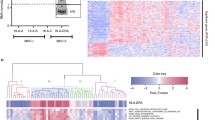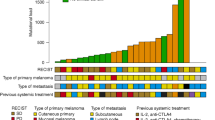Abstract
Evidence for the in vitro lymphocyte response against autologous melanoma has been accumulating over the past 10 years, leading to the identification of numerous melanoma-associated antigens recognised by T cells. These antigens are targets for specific immunotherapy protocols. However, their expression is heterogeneous during tumour progression and may contribute to therapeutic escape mechanisms and disease progression. This study was designed to chart the importance of these escape mechanisms, and to assess the relationship between gene expression and the clinical profile (especially survival data) of patients with melanoma. We studied the expression of certain melanoma genes in tissue biopsies from 202 patients using reverse transcriptase-polymerase chain reaction (RT-PCR). The evaluated genes were Melan-A, tyrosinase, Na-17A, MAGE-1, MAGE-3 and Ny-ESO-1. We then correlated the results to the patients’ survival data. 202 samples (cutaneous, nodal and visceral biopsies) were analysed by RT-PCR. No relationship was found between clinical data and gene expression. No relationship was found between survival data and gene expression, when samples of all stages were combined in the analysis. However, interactions between gene expression and disease stage were significant. When stage III samples alone were considered, MAGE-3 expression alone or in association with the expression of the other tumour-specific genes was found to be significantly associated with a higher disease-free survival (respectively, P = 0.0349; 0.007). Our results provided no evidence for a relationship between gene expression and clinical data, or between gene expression and survival data. However, with regard to certain sub-groups, such as stage III samples, tumour gene expression was significantly associated with survival.




Similar content being viewed by others
References
Balch CM, Buzaid AC, Soong SJ et al (2001) Final version of the American Joint Committee on Cancer staging system for cutaneous melanoma. J Clin Oncol 19:3635–3648
Barrow C, Browning J, Macgregor D et al (2006) Tumor antigen expression in melanoma varies according to antigen and stage. Clin Cancer Res 12:673–678. doi:10.1158/1078-0432.CCR-05-1544
Bulliard JL (2000) Site-specific risk of cutaneous malignant melanoma and pattern of sun exposure in New Zealand. Int J Cancer 85:627–632
De Vries JJ, Smeets M, de Graaf R et al (2001) Expression of gp100, MART-1, tyrosinase, and S100 in paraffin-embedded primary melanomas and locoregional, lymph node, and visceral metastases: implications for diagnosis and immunotherapy. A study conducted by the EORTC Melanoma Cooperative Group. J Pathol 193(1):13–20
Enk CD, Lotem M, Gimon Z (2004) Molecular detection of MART1, tyrosinase and MIA in peripheral blood, lymph nodes and metastatic sites of stage III/IV melanoma patients. Melanoma Res 14(5):361–365
Farthmann B (1998) RT-PCR tyrosinase–mRNA–positive cells in peripheral blood: evaluation strategy and correlation with known prognostic markers in 123 melanoma patients. J Invest Dermatol 110(3):263–267
Hsueh EC, Nathanson L, Foshag LJ et al (1999) Active specific immunotherapy with polyvalent melanoma cell vaccine for patients with in-transit melanoma metastases. Cancer 85:2160–2169
Jäger E, Ringhoffer M, Altmannsberger M et al (1997) Immunoselection in vivo: independent loss of CMH class I and melanocyte differentiation antigen expression in metastatic melanoma. Int J Cancer 71:142–147
Jäger E, Ringhoffer M, Dienes HP et al (1996) Granulocyte–macrophage-colony-stimulating factor enhances immune responses to melanoma-associated peptides in vivo. Int J Cancer 67:54–62
Morton DL, Barth A (1996) Vaccine therapy for malignant melanoma. CA Cancer J Clin 46:225–244
Morton D, Foshag LJ, Hoon DS et al (1992) Prolongation of survival in metastatic melanoma after active specific immunotherapy with a new polyvalent melanoma vaccine. Ann Surg 216:463–482
Parisi AV, Kimlin MG, Lester R, Turnbull D (2003) Lower body anatomical distribution of solar ultraviolet radiation on the human form in standing and sitting postures. J Photochem Photobiol B 69:1–6
Parmiani G, Castelli C, Dalerba P et al (2002) Cancer immunotherapy with peptide-based vaccines: what have we achieved? Where are we going? J Natl Cancer Inst (Bethesda) 94:805–818
Rigel DS (2008) Cutaneous ultraviolet exposure and its relationship to the development of skin cancer. J Am Acad Dermatol 58(S2):S129–S132
Sarantou T, Chi DD, Garrison DA et al (1997) Melanoma associated antigens as messenger RNA detection markers for melanoma. Cancer Res 57:1371–1376
Scheibenbogen C, Nagorsen D, Seliger B et al (2002) Long term freedom from recurrence in 2 stage melanoma patients following vaccination with tyrosinase peptides. Int J Cancer 99:403–408
Takeuchi H, Kuo C, Morton DL et al (2003) Expression of differentiation Melanoma-associated antigen genes is associated with favorable disease outcome in advanced-stage melanomas. Cancer Res 63:441–448
Trefzer U, Hofmann M, Reinke S (2006) Concordant loss of melanoma differentiation antigens in synchronous and asynchronous melanoma metastases: implications for immunotherapy. Melanoma Res 16(2):137–145
Velasquez EF, Jungblut AA, Yancovitz M et al (2007) Expression of the cancer/testis antigen NY-ESO-1 in primary and metastatic malignant melanoma (MM)—correlation with prognostic factors. Cancer Immun 12:7–11
Acknowledgments
Statement of funding: La Ligue contre le Cancer (ligue 2005), Cancer-immunotherapy (sixth framework programme), INSERM.
Conflict of interest statement
None.
Author information
Authors and Affiliations
Corresponding author
Rights and permissions
About this article
Cite this article
Vourc’h-Jourdain, M., Volteau, C., Nguyen, J.M. et al. Melanoma gene expression and clinical course. Arch Dermatol Res 301, 673–679 (2009). https://doi.org/10.1007/s00403-009-0944-8
Received:
Revised:
Accepted:
Published:
Issue Date:
DOI: https://doi.org/10.1007/s00403-009-0944-8




